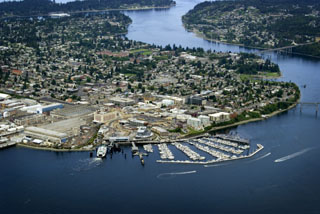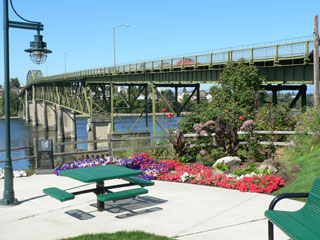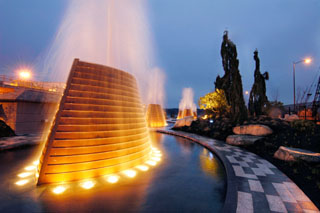
DJC.COM
September 25, 2008
Redevelopment: fraught with challenges, but worth the plunge
City of Bremerton

Bozeman
|
Redeveloping an urban waterfront is one of the most challenging initiatives a local government can undertake.
You’ve got to convince the community to buy into the idea. At the same time, you must get an array of governments and regulatory entities, which often have diametrically opposed views on how a particular shoreline should be used, on board and pulling in the same direction.
Once you’ve achieved these not-so-easy tasks, you have to hire the most-qualified consultants — experts who are well versed in the constantly evolving best practices on an eclectic array of topics, from permitting to transportation to finance. These consultants not only have to be the best in the business, they must work well with each other, with the various governmental entities and with the public.

Photo courtesy of the city of Bremerton The Bremerton waterfront’s dismal string of surface parking lots once earned the town the nickname Bummerton. Its downtown, now called the Harborside District, has seen $500 million in new construction since 2000. |
If you can pull it off, you’ll attract the private capital whose investment will give your project the market’s stamp of approval. If investors do come knocking, you need to be sure that their ideas match the community’s vision.
No matter how you slice it, redeveloping urban waterfronts is a conundrum. Yet communities from coast to coast are investing enormous resources into revitalization efforts. In Washington state, the list is long: Seattle, Tacoma, Everett, Bellingham, Olympia, Aberdeen, Mount Vernon, Oak Harbor, Gig Harbor, Des Moines, Vancouver, Wenatchee. This is but a partial list.
Worth the effort
They’re undertaking the challenge because vibrant waterfronts are incredible economic engines. In Bremerton, we’ve seen the benefits of a successful revitalization. Our sales tax revenue is up nearly 9 percent annually. Officials in Wenatchee, which is undergoing a similar renaissance, project that businesses will see revenues increase by as much as $152 million annually. This will generate $2 million in new tax revenues.
There’s more to the motivation, however, than revenue. Revitalizing waterfronts is the right thing to do. The projects, when done correctly, create invaluable public places, and they are a source of tremendous community pride. In addition, they greatly improve the environment, often transforming contaminated eyesores into places where marine life flourishes. What Tacoma has done along the Thea Foss Waterway proves that.

Photo courtesy of the city of Bremerton The city worked with government agencies and private developers to invest in infrastructure, from transportation amenities to parks. |
In Bremerton, we launched a campaign about eight years ago to revitalize our waterfront. We started with the belief that the waterfront belongs to the community while embracing our need to preserve our principal employer: the Puget Sound Naval Shipyard.
With an anemic tax base and little money of our own, we formed partnerships. In addition to the shipyard, we worked with other local government agencies, state and federal governments and private developers, such as Opus Northwest.
Together, we invested in high-quality public infrastructure, from parks to transportation amenities, including a $37 million multimodal transit hub at the ferry terminal. Now other private development is beginning to flow into our city.
Information sharing
Almost every week, cities contact us to find out how we’re doing it. This is why we decided to host our first Urban Waterfront Revitalization Conference earlier this month.
When we started planning the conference, we realized that one size does not fit all. So we invited mayors and council members from waterfront cities across North America. Sausalito, Calif., Annapolis, Md., and Sidney, Vancouver and North Vancouver, British Columbia, were represented along with Olympia and Wenatchee.
We also had some of the nation’s leading consultants. They led discussions about the most-innovative services and solutions that communities are using to redevelop their waterfronts. Financing, transportation, public engagement, permitting and design were among the topics they covered.
So much was discussed during the three-day conference that it’s impossible to distill down all of the information collected. But if I had to offer fellow mayors Five Top Tips to Redeveloping Your Waterfront, they would be:
• Balance your dreams for your community’s waterfront with what the public wants. Be flexible. If you’re not, you’re setting yourself up to fail.
• Branding is vital. (Think Sausalito.) Bremerton didn’t have that cache when we started our redevelopment. Back then, our waterfront was a dismal string of ugly surface parking lots, and we were known as Bummerton. So we rebranded our downtown as the Harborside District.

Photo by Glen Davis The Harborside Fountain Park, located next to the ferry terminal, is one of the newest additions to Bremerton’s waterfront. A path of granite pavers weaves between native plants and five copper-clad fountains that periodically shoot bursts of water. |
• Engage private and public entities early in the process. Secure partnerships with state and federal governments, which can be tremendous sources for grants.
• Never sacrifice quality for quantity. Excellence is not negotiable.
• Take small steps and go one project at a time.
As an industry, reclamation of waterfronts is in its infancy. The amount of work left to do in our region and beyond is staggering, which is not surprising since these irreplaceable resources have been misused and degraded for centuries. It’s going to require generations of hard work and information sharing to turn this situation around, which is why we are considering making the Bremerton conference an annual event.
Regular conferences are not enough, however. Our conference producer, Kirkland-based Athena Institute, a research consultancy, is launching the Urban Waterfront Alliance. The group will foster year-round networking among service providers and community leaders and keep members abreast of shifting best practices for shoreline redevelopment. Together, we can make it happen.
Revitalizing a waterfront can be so daunting that it’s tempting to dismiss it as hopeless. When staring down this kind of pessimism remember this tidbit, which Gary Penway, North Vancouver’s waterfront development project manager, shared during our conference: Waterfront redevelopment is an iterative process. Know that your community very likely will not “get there” in your lifetime.
You may not see the end results, but future generations will.
Cary Bozeman is mayor of Bremerton, which is redeveloping its downtown waterfront. Since 2000, more than $500 million in new construction has been completed in the city’s Harborside District, which is home to new restaurants, shops, galleries, condominiums and office space, and the new Naval Maritime Museum.
Other Stories:
- Put mixed uses where they belong — by the water
- 5 principles for renewing Seattle’s waterfront
- Group efforts make for better shorelines
- Seattle’s waterfront a showcase of lost opportunities
- Competing goals drive Anacortes marina project
- Great civic developments need private know-how
Copyright ©2009 Seattle Daily Journal and DJC.COM.
Comments? Questions? Contact us.